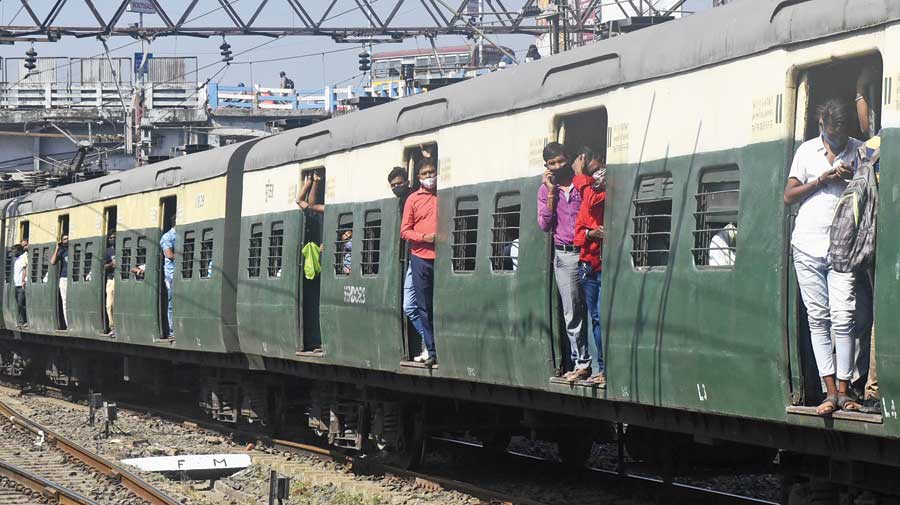Packed trains on Day One of resumption of suburban services left implementation of pandemic protocols largely to individual passengers and bared the risks of running a curtailed fleet.
Railway officials said no one was allowed to enter a station or board a train without a mask.
Many passengers underwent random thermal screening at stations. But beyond that, other Covid-19 protocols went for a toss at most places as the day progressed.

A Howrah station platform after passengers got off a train on Wednesday morning. Bishwarup Dutta
The seats on the trains have been marked alternately to maintain physical distancing. Some early morning trains saw passengers adhering to the markers. But as the day progressed, no seat was left vacant. During the office hours, many compartments had no place to stand as well.
A state government official said it was unfair to blame passengers crowding train compartments because “most of them are driven by livelihood demands”.
A substantial number of people from districts, who come to Calcutta for work,
are dependent on suburban trains. Their livelihood had been crippled by the suspension of the services.
A fleet of 696 trains was announced in the run-up to the resumption. But on Wednesday, additional trains had to be run in both Howrah and Sealdah divisions to accommodate a surge in the number passengers, said railway officials.
But the number was still far less than 1,500, the usual quota of daily local trains before the pandemic forced suspension of services in March.
In the absence of enough trains, implementation of pandemic protocols was left largely to passengers.
Howrah, Sealdah and Dum Dum stations saw a sizeable deployment of RPF, GRP and state police personnel. In the early hours of the day, the cops were proactive in ensuring that people stood according to the markers drawn on the platforms. As the crowd kept swelling, the markers were rendered useless at many places. At smaller stations in Calcutta and outside the city, social distancing seemed a distant dream.
Around 10am, the Sealdah-bound Lakshmikantapur local entered Ballygunge station. Swarms of passengers made their way out of the compartments. But the train was still packed to the hilt. Four persons sat on most benches meant for three people.
Around 100 people were jostling for space at the ticket counter at Serampore station around the same time.
Around 9am, GRP personnel at Baruipur station were struggling to streamline passengers waiting for a Sealdah-bound train.
“When I boarded the train at Barrackpore, it was packed but I found a place to stand. By the time the train went past Sodepur, there was hardly any place to stand as many more entered the same compartment,” said Atanu Ghosh, a Barrackpore resident who got off at Dum Dum.
Pinaki Ghosh, a Serampore resident who works with a retail pharmacy chain’s outlet in central Calcutta, took a train to Howrah at the first chance on Wednesday. “The train was crowded but I reached my work place within 50 minutes. Till now, I used to ride a bike and it would take well over 90 minutes to come to work,” said Ghosh.
Railway officials said the first day was better than expected. “The normal seating capacity of a train is 1,200. During office hours, around 4,000 people travel on every single train. On Wednesday, the number seemed around 2,000 during office hours. Two thousand people on a train are a lot but not like it used to be before the pandemic,” said an official of the Sealdah division.
An official of the Howrah division said some trains on the Bandel route were most crowded. “But we had feared a bigger turnout. Perhaps some people are still wary,” said the official.
But both divisions saw more trains than announced earlier. The Howrah division was allotted around 200 trains but over 275 ran. The Sealdah division also saw more trains than announced earlier.
“We were prepared to run additional services according to the rush. Most of the additional services were run during the morning and evening rush hours,” said an official of the Howrah division.











